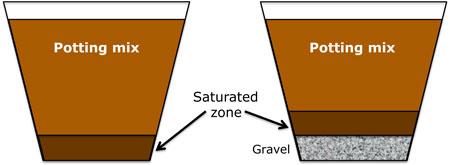Drainage in Containers
It's a common myth that we should put gravel or other coarse-textured material in the bottom of a container to improve drainage. It seems intuitive that it should work, but our intuition is wrong. Here's why.
A well-watered container of potting mix always has a saturated layer at the bottom. When you put a layer of gravel at the bottom of the pot, the saturated layer simply moves up. The layer of gravel actually reduces the usable depth and brings the saturated soil layer closer to the plant's roots.

The reason is that water does not move easily from a layer of fine-textured material to a layer of coarse-textured material. Water moves through soil by the forces of gravity and capillarity. Very small, capillary-sized pores in potting soil allow water to be pulled downward through the pore spaces to the bottom of the pot. Only when the whole pot is saturated does water move downward by gravitational force. Layers of gravel, clay pot shards, or similar coarse materials contain few if any small capillary pores. If a layer of such material is in the bottom of a pot, the downward movement of water (i.e., drainage) will stop when the water encounters the coarse layer. The water will remain in a band of soil just above the interface of the two materials.
If drainage holes in a container are too large and the potting soil comes out of the holes, you can place a few shards of material over the holes, but no more than that.
To give a plant improved drainage, you can either
- amend the potting mix by adding coarse materials such as perlite, crushed lava, or pumice, or
- choose a deeper container, so the roots will have more soil depth that remains well drained and unsaturated
Adapted from California Master Gardener Handbook, Dennis Pittenger






